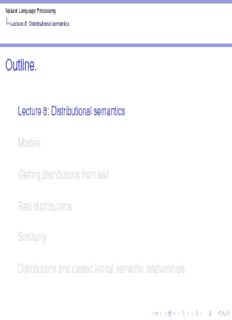
Natural Language Processing PDF
Preview Natural Language Processing
NaturalLanguageProcessing Lecture8:Distributionalsemantics Outline. Lecture 8: Distributional semantics Models Getting distributions from text Real distributions Similarity Distributions and classic lexical semantic relationships NaturalLanguageProcessing Lecture8:Distributionalsemantics Outline Lecture 8: Distributional semantics Models Getting distributions from text Real distributions Similarity Distributions and classic lexical semantic relationships NaturalLanguageProcessing Lecture8:Distributionalsemantics Introduction to the distributional hypothesis ◮ From last time: Issues for broad coverage systems: ◮ Boundarybetweenlexicalmeaningandworldknowledge. ◮ Representinglexicalmeaning. ◮ Acquiringrepresentations. ◮ Polysemyandmultiwordexpressions. ◮ Distributional hypothesis: word meaning can be represented by the contexts in which the word occurs. ◮ First experiments in 1960s, now practically usable. NaturalLanguageProcessing Lecture8:Distributionalsemantics Distributional semantics Distributional semantics: family of techniques for representing word meaning based on (linguistic) contexts of use. it was authentic scrumpy, rather sharp and very strong we could taste a famous local product — scrumpy spending hours in the pub drinking scrumpy ◮ Use linguistic context to represent word and phrase meaning (partially). ◮ Meaning space with dimensions corresponding to elements in the context (features). ◮ Most computational techniques use vectors, or more generally tensors: aka semantic space models, vector space models. NaturalLanguageProcessing Lecture8:Distributionalsemantics Distributional semantics Distributional semantics: family of techniques for representing word meaning based on (linguistic) contexts of use. it was authentic scrumpy, rather sharp and very strong we could taste a famous local product — scrumpy spending hours in the pub drinking scrumpy ◮ Use linguistic context to represent word and phrase meaning (partially). ◮ Meaning space with dimensions corresponding to elements in the context (features). ◮ Most computational techniques use vectors, or more generally tensors: aka semantic space models, vector space models. NaturalLanguageProcessing Lecture8:Distributionalsemantics Distributional semantics Distributional semantics: family of techniques for representing word meaning based on (linguistic) contexts of use. it was authentic scrumpy, rather sharp and very strong we could taste a famous local product — scrumpy spending hours in the pub drinking scrumpy ◮ Use linguistic context to represent word and phrase meaning (partially). ◮ Meaning space with dimensions corresponding to elements in the context (features). ◮ Most computational techniques use vectors, or more generally tensors: aka semantic space models, vector space models. NaturalLanguageProcessing Lecture8:Distributionalsemantics Distributional semantics Distributional semantics: family of techniques for representing word meaning based on (linguistic) contexts of use. it was authentic scrumpy, rather sharp and very strong we could taste a famous local product — scrumpy spending hours in the pub drinking scrumpy ◮ Use linguistic context to represent word and phrase meaning (partially). ◮ Meaning space with dimensions corresponding to elements in the context (features). ◮ Most computational techniques use vectors, or more generally tensors: aka semantic space models, vector space models. NaturalLanguageProcessing Models Outline. Lecture 8: Distributional semantics Models Getting distributions from text Real distributions Similarity Distributions and classic lexical semantic relationships NaturalLanguageProcessing Models The general intuition ◮ Distributions are vectors in a multidimensional semantic space, that is, objects with a magnitude (length) and a direction. ◮ The semantic space has dimensions which correspond to possible contexts. ◮ For our purposes, a distribution can be seen as a point in that space (the vector being defined with respect to the origin of that space). ◮ scrumpy [...pub 0.8, drink 0.7, strong 0.4, joke 0.2, mansion 0.02, zebra 0.1...] NaturalLanguageProcessing Models The notion of context ◮ Word windows (unfiltered): n words on either side of the lexical item. Example: n=2 (5 words window): ... the prime minister acknowledged that ... ◮ Word windows (filtered): n words on either side removing some words (e.g. function words, some very frequent content words). Stop-list or by POS-tag. Example: n=2 (5 words window): ... the prime minister acknowledged that ... ◮ Lexeme window (filtered or unfiltered); as above but using stems.
Description: